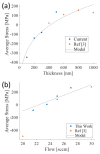Compensation of the Stress Gradient in Physical Vapor Deposited Al1-xScxN Films for Microelectromechanical Systems with Low Out-of-Plane Bending
- PMID: 35893167
- PMCID: PMC9394260
- DOI: 10.3390/mi13081169
Compensation of the Stress Gradient in Physical Vapor Deposited Al1-xScxN Films for Microelectromechanical Systems with Low Out-of-Plane Bending
Abstract
Thin film through-thickness stress gradients produce out-of-plane bending in released microelectromechanical systems (MEMS) structures. We study the stress and stress gradient of Al0.68Sc0.32N thin films deposited directly on Si. We show that Al0.68Sc0.32N cantilever structures realized in films with low average film stress have significant out-of-plane bending when the Al1-xScxN material is deposited under constant sputtering conditions. We demonstrate a method where the total process gas flow is varied during the deposition to compensate for the native through-thickness stress gradient in sputtered Al1-xScxN thin films. This method is utilized to reduce the out-of-plane bending of 200 µm long, 500 nm thick Al0.68Sc0.32N MEMS cantilevers from greater than 128 µm to less than 3 µm.
Keywords: MEMS; aluminum scandium nitride; cantilever beams; fabrication; physical vapor deposition; stress; stress gradient.
Conflict of interest statement
The authors declare no conflict of interest.
Figures








References
-
- Esteves G., Berg M., Wrasman K.D., Henry M.D., Griffin B.A., Douglas E.A. CMOS compatible metal stacks for suppression of secondary grains in Sc0.125Al0.875N. J. Vac. Sci. Technol. A Vac. Surf. Film. 2019;37:021511. doi: 10.1116/1.5065517. - DOI
-
- Olsson R.H., Tang Z., D’Agati M. Doping of aluminum nitride and the impact on thin film piezoelectric and ferroelectric device performance; Proceedings of the 2020 IEEE Custom Integrated Circuits Conference (CICC); Boston, MA, USA. 22–25 March 2020; New York, NY, USA: IEEE; 2020. pp. 1–6.
-
- Beaucejour R., Roebisch V., Kochhar A., Moe C., Hodge D., Olsson R.H., III Controlling Residual Stress and Suppression of Anomalous Grains in Aluminum Scandium Nitride Films Grown Directly on Silicon. [(accessed on 1 June 2022)];J. Microelectromech. Syst. 2022 :1–8. doi: 10.1109/JMEMS.2022.3167430. Available online: https://ieeexplore.ieee.org/document/9770129. - DOI
-
- Hong Y., Sui L., Zhang M., Shi G. Theoretical analysis and experimental study of the effect of the neutral plane of a composite piezoelectric cantilever. Energy Convers. Manag. 2018;171:1020–1029. doi: 10.1016/j.enconman.2018.06.045. - DOI
-
- Wang Q.M., Yang Z., Li F., Smolinski P. Analysis of thin film piezoelectric microaccelerometer using analytical and finite element modeling. Sens. Actuators Phys. 2004;113:1–11. doi: 10.1016/j.sna.2004.02.041. - DOI
Grants and funding
LinkOut - more resources
Full Text Sources

